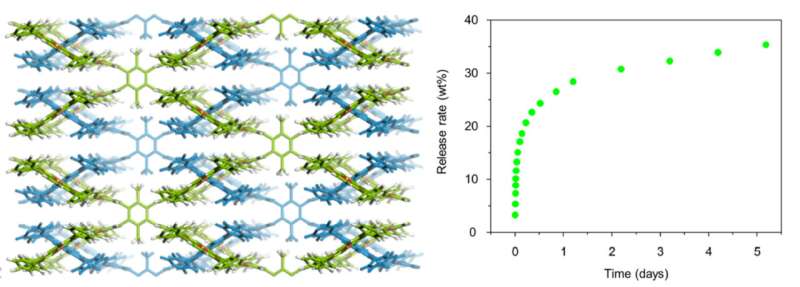TUS-84, the novel 3D COF developed at the Tokyo University of Science, exhibits a unique double interpenetrating structure with well-defined voids (left), as well as an extended drug release performance of about 35% after 5 days (right), indicating its potential application in drug delivery. Credit: Yuichi Negishi from Tokyo University of Science
In our quest for clean energy and sustainable health solutions, advanced materials with unique, customizable properties play a crucial role. Among them, a new generation of porous solids known as three dimensional (3D) covalent organic frameworks (COFs) have generated considerable interest owing to potential applications in catalysis, separation, semiconduction, proton conduction, and biomedicine.
The novelty of these materials lies in their synthesis as well as their applications. 3D COFs are porous organic materials developed from linking molecular building blocks with strong covalent bonds into crystalline, extended, net-like reticular three-dimensional structures.
However, synthesis of 3D COFs from pre-designed building units leading to net-like "reticular" arrangement of constituent parts or "network topologies" remains challenging. This is due to the shortage of 3D building units and inadequate reversibility of the linkages between the building units.
Recently, Professor Yuichi Negishi from the Department of Applied Chemistry, Faculty of Science, Tokyo University of Science, Japan, and his colleagues in the Department of Applied Chemistry, Tokyo University of Science, Dr. Saikat Das, Mr. Taishu Sekine, and Ms. Haruna Mabuchi have succeeded for the first time in creating a novel 3D COF unique networked topology.
"In this study, we have succeeded for the first time in creating a 3D COF with scu-c topology (network structure) by connecting nodes of a regular plane (4-connected) with nodes of a regular prism (8-connected). This new COF, i.e., TUS-84, has a double interpenetrating structure with well-defined voids," says Prof. Negishi. The study has been published in ACS Applied Materials & Interfaces.
As a part of the study, the researchers performed a condensation reaction of two organic linkers called DPTB-Me and TAPP with different symmetries, to yield 3D COF with an scu-c net-like arrangement of constituents.
The team then conducted powder X-ray diffraction (PXRD) and high-resolution transmission electron microscopy (HRTEM) to analyze the crystal structure and properties of the synthesized 3D COF. The researchers also conducted structural modeling and simulation, which showed great alignment with the observed experimental features while providing further structural insights.
The researchers further demonstrated that the synthesized 3D COF has excellent hydrogen, carbon dioxide, and methane adsorption properties that reinforces its prospects in carbon capture and clean energy applications. As Prof. Negishi notes, "The development of appropriate COFs also facilitates the recovery of metal resources and noble gases, such as argon, in an energy-efficient way. This contributes to the improvement of resource and energy problems."
The icing on the cake for this novel 3D COF is its efficiency in drug delivery applications. The team unveiled TUS-84's drug delivery capabilities with efficient drug loading and sustained release profiles using ibuprofen, a common nonsteroidal anti-inflammatory drug. TUS-84 showed an extended drug release performance of about 35% after 5 days. This facilitates the delivery of sustained concentrations of drug over a prolonged period. As a result, dose frequency could be reduced, and more consistent control of long-lasting, chronic pain could be possible.
The findings of this study pave the way toward the development of future 3D COFs with unique topologies for applications across a wide range of fields, from medicine to environmental remediation.
More information: Saikat Das et al, Three-Dimensional Covalent Organic Framework with scu-c Topology for Drug Delivery, ACS Applied Materials & Interfaces (2022). DOI: 10.1021/acsami.2c15152
Journal information: ACS Applied Materials and Interfaces
Provided by Tokyo University of Science
























